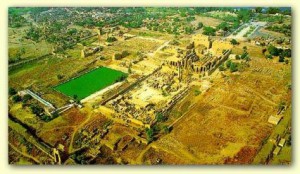El-Karnak is a small village in Egypt, located on the banks of the River Nile some 2.5 km north of Luxor. It stands at 25°43’N 32°39’E. Visitors to the area – particularly foreign tourists – perceive no distinction between Luxor and el-Karnak, as the two are both parts of the same conurbation. Karnak Temple is the leading attraction in el-Karnak. Essentially this is el-Karnak. The very term Karnak is nearly universally understood as the temple complex and not the village. It is twice the size of the built-up village area.
 It is a vast open-air museum and the largest ancient religious site in the world, and is probably the second most visited ancient site in Egypt, second only to the Giza Pyramids near Cairo.It consists of four main parts, of which only one is accessible for tourists and the general public. This is also the “main” temple part and by far the largest part. One can probably on that basis redefine the term Karnak, as to be understood as being the Precinct of Amon-Re only, as this is the only part most visitors normally see. The three other parts are closed to the public.
It is a vast open-air museum and the largest ancient religious site in the world, and is probably the second most visited ancient site in Egypt, second only to the Giza Pyramids near Cairo.It consists of four main parts, of which only one is accessible for tourists and the general public. This is also the “main” temple part and by far the largest part. One can probably on that basis redefine the term Karnak, as to be understood as being the Precinct of Amon-Re only, as this is the only part most visitors normally see. The three other parts are closed to the public.
There are also a few smaller temples and sanctuaries located outside the enclosing walls of the four main parts, as well as several avenues of ram-headed sphinxes connecting the Precinct of Mut, the Precinct of Amon-Re and Luxor Temple.The key difference between Karnak and most of the other temples and sites in Egypt is the length of time over which it was developed and used. Construction work began in the 16th century BC. Approximately 30 pharaohs contributed to the buildings, enabling it to reach a size, complexity and diversity not seen elsewhere. Few of the individual features of Karnak are unique, but the size and number of features is overwhelming.